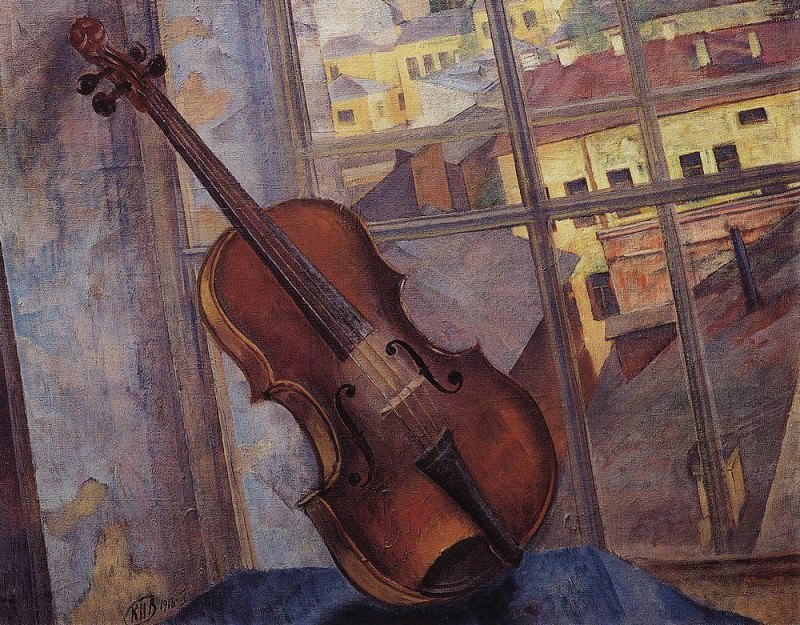Violin. 1918 Kuzma Sergeevich Petrov-Vodkin (1878-1939)
Kuzma Sergeevich Petrov-Vodkin – Violin. 1918
Edit attribution
Download full size: 1000×781 px (0,3 Mb)
Painter: Kuzma Sergeevich Petrov-Vodkin
Location: State Russian Museum, St. Petersburg (Государственный Русский Музей).
Petrov-Vodkin was a Russian cultural figure, painter, and also a theater set designer. In his art he appealed to motifs of religion and the pathos of revolutionary struggle. In the golden fund of the art of the Soviet period was a lot of his works in the genre of still life. He worked very much in this genre in 1918-1920, when he created some beautiful paintings. So in 1918 he painted a picture "Violin", which belongs to this genre.
Description of Kuzma Petrov Vodkin’s painting Violin
Petrov-Vodkin was a Russian cultural figure, painter, and also a theater set designer.
In his art he appealed to motifs of religion and the pathos of revolutionary struggle. In the golden fund of the art of the Soviet period was a lot of his works in the genre of still life. He worked very much in this genre in 1918-1920, when he created some beautiful paintings. So in 1918 he painted a picture "Violin", which belongs to this genre. This painting shows a love for the spiritualized, for music as a way to escape from reality, and it also depicts that real, everyday gray life with the help of houses and other details.
The author said that still lifes were one of the poignant themes during the painter’s conversation with nature, he compared them to violin studies. At first glance the painting depicts simple objects, but with the help of the artist’s peculiar vision, they help to create a special world, poetically transforming reality.
The violin is placed by the window, behind it one can see numerous roofs and courtyards of the city, with the help of its graceful silhouette the musical instrument depicts this sad world, and from it receives a minor coloring.
This work is permeated by a single tense feeling that comes from both the musical instrument depicted and the landscape outside the window.
This piece is now in the State Russian Museum in St. Petersburg.
The main peculiarity of the artist’s artistic thinking was precisely the comprehension of the universal laws of existing forms in time and space and the desire to live a "living life.
To break the static perception of reality, the artist engaged in the construction of perspective for the future, as if trying to view the image from different angles.
Each of his paintings carries a certain meaning.
Кому понравилось
Пожалуйста, подождите
На эту операцию может потребоваться несколько секунд.
Информация появится в новом окне,
если открытие новых окон не запрещено в настройках вашего браузера.
You need to login
Для работы с коллекциями – пожалуйста, войдите в аккаунт (open in new window).




















You cannot comment Why?
Behind the violin, a window frames a view of urban rooftops and buildings. These structures are painted with a looser brushstroke, utilizing blues, greens, and muted yellows, which contrast with the warmer tones of the instrument. The cityscape appears fragmented and somewhat indistinct, suggesting a sense of distance or perhaps emotional detachment from the external world.
The background is not uniformly lit; theres an interplay of light and shadow that adds depth to the scene. A dark band runs along the top edge of the canvas, creating a stark contrast with the lighter tones below and emphasizing the window as a visual barrier. The surface texture appears rough, indicating visible brushstrokes and a deliberate lack of smooth blending.
Subtextually, the painting seems to explore themes of memory, loss, or perhaps longing. The violin, traditionally associated with music and emotional expression, is presented in a static, almost melancholic state. Its placement against the window suggests a separation between interiority and exterior reality – a sense of being confined within ones own thoughts or experiences. The blurred cityscape could represent a fading past or an unreachable future. The overall effect is one of quiet contemplation and understated emotional complexity.